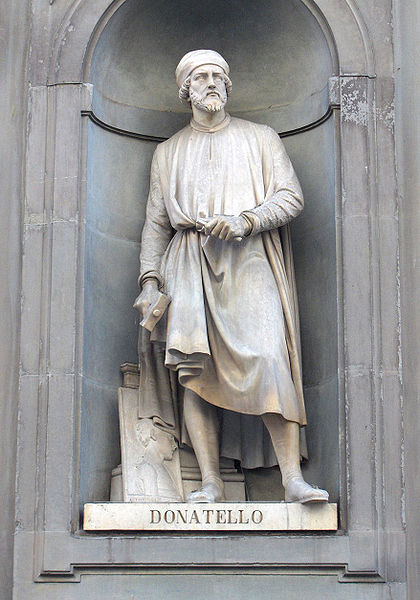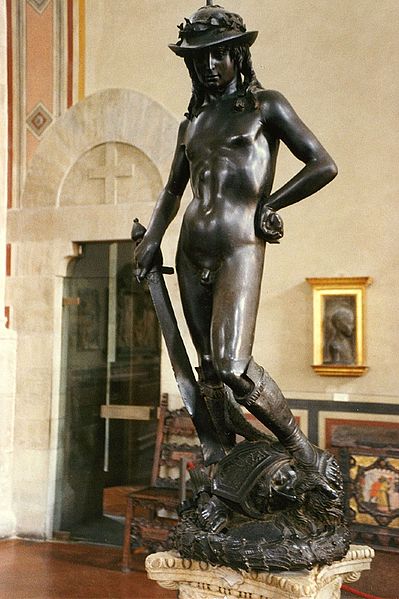Donatello (circa 1386 - December 13, 1466)

Donatello was the finest sculptor of the fifteenth century. He revived and refined the art of classical sculpture in the round, and many of his works are explicitly homoerotic. His David is lissome and his St. George became emblematic of beauty for admirers of the male form.
Donatello was notorious for his love of boys. A surviving story has him chasing, with murderous intent, a young thief, whose beauty winds up charming the artist into forgiveness on sight.
Florentine scholar POLIZIANO, in his book Detti piacevoli, recorded several jokes concerning Donatello’s relationships with young male servants. He noted that the sculptor hired particularly attractive boys, and “stained” them so that no one else would want them; another anecdote was about an assistant who left Donatello after a fight, and how they made up by “laughing” at each other-contemporary slang for having sex.
Main works
"St. Mark" (1411-1413), Orsanmichele, Florence
St. George Tabernacle (c. 1415-1417) - Museo Nazionale del Bargello, Florence
"Prophet Habacuc" (1423-1425) - Museo dell'Opera del Duomo, Florence
"The Feast of Herod" (c. 1425) - Baptismal font, Baptistry of San Giovanni, Siena
"David" (c. 1425-1430) - Museo Nazionale del Bargello, Florence
"Equestrian Monument of Gattamelata" (1445-1450) - Piazza del Santo, Padua
"Magdalene Penitent" (c. 1455) - Museo dell'Opera del Duomo, Florence
"Judith and Holofernes" (1455-1460) - Palazzo Vecchio, Florence
"Virgin and Child with Four Angels" or "Chellini Madonna" (1456), Victoria and Albert Museum




Stern, Keith (2009-09-01). Queers in History: The Comprehensive Encyclopedia of Historical Gays, Lesbians and Bisexuals (Kindle Locations 4407-4415). Perseus Books Group. Kindle Edition.
Further Readings:

The Renaissance Portrait: From Donatello to Bellini (Metropolitan Museum of Art) by Keith Christiansen and Stefan Weppelmann
Hardcover: 432 pages
Publisher: Metropolitan Museum of Art (November 29, 2011)
Language: English
ISBN-10: 0300175914
ISBN-13: 978-0300175912
Amazon: The Renaissance Portrait: From Donatello to Bellini (Metropolitan Museum of Art)
In the words of cultural historian Jacob Burkhardt, fifteenth-century Italy was "the place where the notion of the individual was born." In keeping with that idea, early Renaissance Italy was a key participant in the first great age of portraiture in Europe. As groundbreaking artists strove to evoke the identity or personality of their sitters-from heads of state and church, military commanders, and wealthy patrons to scholars, poets, and artists-they evolved daring new representational strategies that would profoundly influence the course of Western art. More than a mere likeness, the fifteenth-century Italian portrait was an attempt to wrest from the unpredictability of life and the shadow of mortality and image that could be passed down to future generations.
The Renaissance Portrait, which accompanies a landmark exhibition at the Bode-Museum, Berlin, and The Metropolitan Museum of Art, New York, provides new research and insight into the early history of portraiture in Italy, examining in detail how its major art centers-Florence, the princely courts, and Venice-saw the rapid development of portraiture as closely linked to Renaissance society and politics, ideas of the individual, and concepts of beauty. Essays by leading scholars provide a thorough introduction to Renaissance portraiture, while individual catalogue entries illustrate and extensively discuss more than 160 magnificent examples of painting, drawing, manuscript illumination, sculpture, and medallic portraiture by such artists as Donatello, Filippo Lippi, Botticelli, Verrocchio, Ghirlandaio, Pisanello, Mantegna, Antonello da Messina, and Giovanni Bellini. With abundant style and visual ingenuity, these masters transformed the plain facts of observation into something beautiful to behold.
More Artists at my website: http://www.elisarolle.com/, My Ramblings/Art
This journal is friends only. This entry was originally posted at http://reviews-and-ramblings.dreamwidth.org/3387661.html. If you are not friends on this journal, Please comment there using OpenID.